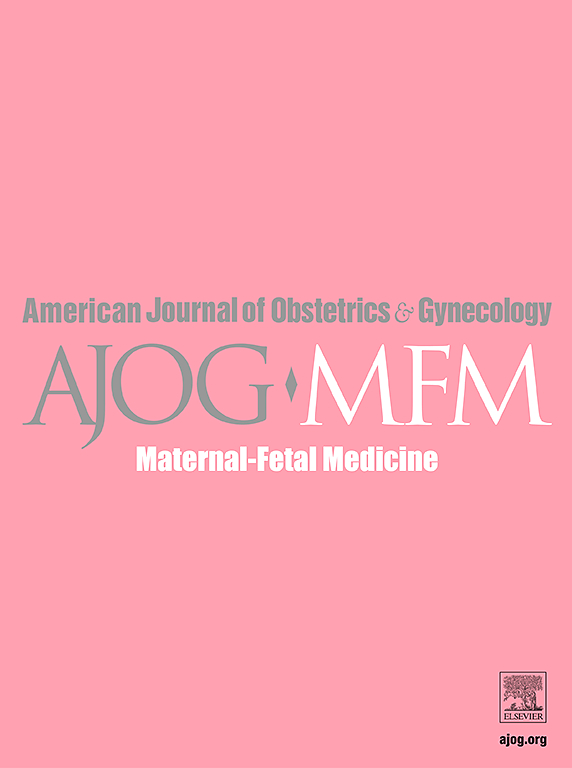在分娩前观看教育视频对可能的产科急诊的影响:一项随机对照试验。
IF 3.1
2区 医学
Q1 OBSTETRICS & GYNECOLOGY
American Journal of Obstetrics & Gynecology Mfm
Pub Date : 2025-08-27
DOI:10.1016/j.ajogmf.2025.101774
引用次数: 0
摘要
背景:虽然提供有关潜在产科紧急情况的详细信息的重要性得到广泛承认,但在对未分娩妇女的常规护理中,这一问题往往得不到一致的解决。目的:评价产程可能发生的产科急诊教育视频对未产妇女阴道分娩时产妇焦虑和分娩体验的影响。研究设计:这项随机对照试验招募了足月未分娩的妇女,她们被随机分配到干预组或对照组。干预组观看了一段由我科制作的5分钟的教育视频,内容涵盖了分娩和常见产科急诊的管理。对照组接受标准产科护理。使用状态-特质焦虑量表(STAI)在三个不同的时间点评估焦虑:招募时(STAI 1),进入产房时(STAI 2)和产后(STAI 3)。两组均完成了一份包含11个项目的分娩经历问卷(CEQ)。结果:共接触了161名参与者,其中127人完成了研究问卷并纳入最终分析(干预63人,对照组64人)。两组间基线焦虑(STAI 1)和入院时焦虑(STAI 2)具有可比性。视频组的产后即时焦虑(STAI 3)显著降低(28 [22-33]vs. 33 [26-38]; p = 0.01),在多变量分析中,这种降低仍然显著(调整系数:-5.1;95% CI: -9.2至-1.1;p = 0.01)。视频组从招募到产后(Δ STAI 3-1: -15.5[-24至-5]vs. -9[-18至0];p = 0.02)和从入院到产后(Δ STAI 3-2: -12.5[-20至-3]vs. -7[-12至0];p = 0.01)观察到更大的焦虑减轻。两组间CEQ得分相似。结论:产前教育视频可显著减少产后焦虑,显示其作为一种简单、可扩展的干预手段,具有改善产妇心理健康的潜力。本文章由计算机程序翻译,如有差异,请以英文原文为准。
The impact of watching an educational video on possible obstetric emergencies before labor: a randomized controlled trial
Background
While the importance of providing detailed information about potential obstetric emergencies is widely acknowledged, it is often inconsistently addressed in routine care for nulliparous women.
Objective
To evaluate the effect of an educational video of possible obstetric emergencies during labor on maternal anxiety and childbirth experience among nulliparous women anticipating vaginal delivery.
Study Design
This randomized controlled trial enrolled nulliparous women at term, who were randomly assigned to an intervention group or a control group. The intervention group watched a 5-minute educational video, developed by our department, which covered the management of labor and common obstetric emergencies. The control group received standard obstetric care. Anxiety was evaluated at three distinct time points using the State-Trait Anxiety Inventory (STAI): At recruitment (STAI 1), upon admission to the delivery room (STAI 2), and the postpartum (STAI 3). Both groups completed an 11-item Childbirth Experience Questionnaire (CEQ).
Results
A total of 161 participants were approached, with 127 completing the study questionnaires and included in the final analysis (63 intervention, 64 control). Baseline anxiety (STAI 1) and anxiety at admission (STAI 2) were comparable between groups. Immediate postpartum anxiety (STAI 3) was significantly lower in the video group (28 [22–33] vs 33 [26–38]; P=.01), with this reduction remaining significant in multivariable analysis (adjusted coefficient: −5.1; 95% CI: −9.2 to −1.1; P=.01). Greater anxiety reductions were observed in the video group from recruitment to postpartum (Δ STAI 3-1: −15.5 [−24 to −5] vs −9 [−18 to 0]; P=.02) and from admission to postpartum (Δ STAI 3-2: −12.5 [−20 to −3] vs −7 [−12 to 0]; P=.01). CEQ scores were similar between groups.
Conclusion
A prelabor educational video significantly reduced postpartum anxiety, highlighting its potential as a simple and scalable intervention to enhance maternal mental health.
求助全文
通过发布文献求助,成功后即可免费获取论文全文。
去求助
来源期刊

American Journal of Obstetrics & Gynecology Mfm
Medicine-Medicine (all)
CiteScore
7.40
自引率
3.20%
发文量
254
审稿时长
40 days
期刊介绍:
The American Journal of Obstetrics and Gynecology (AJOG) is a highly esteemed publication with two companion titles. One of these is the American Journal of Obstetrics and Gynecology Maternal-Fetal Medicine (AJOG MFM), which is dedicated to the latest research in the field of maternal-fetal medicine, specifically concerning high-risk pregnancies. The journal encompasses a wide range of topics, including:
Maternal Complications: It addresses significant studies that have the potential to change clinical practice regarding complications faced by pregnant women.
Fetal Complications: The journal covers prenatal diagnosis, ultrasound, and genetic issues related to the fetus, providing insights into the management and care of fetal health.
Prenatal Care: It discusses the best practices in prenatal care to ensure the health and well-being of both the mother and the unborn child.
Intrapartum Care: It provides guidance on the care provided during the childbirth process, which is critical for the safety of both mother and baby.
Postpartum Issues: The journal also tackles issues that arise after childbirth, focusing on the postpartum period and its implications for maternal health. AJOG MFM serves as a reliable forum for peer-reviewed research, with a preference for randomized trials and meta-analyses. The goal is to equip researchers and clinicians with the most current information and evidence-based strategies to effectively manage high-risk pregnancies and to provide the best possible care for mothers and their unborn children.
 求助内容:
求助内容: 应助结果提醒方式:
应助结果提醒方式:


